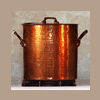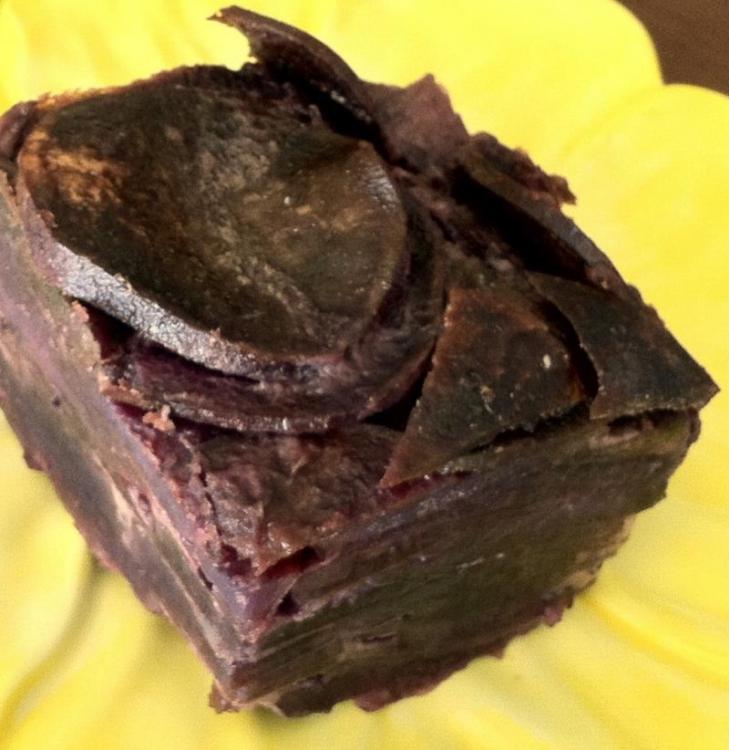-
Posts
1,307 -
Joined
-
Last visited
Content Type
Profiles
Forums
Store
Help Articles
Everything posted by David A. Goldfarb
-
The problem does seem to be endemic to the motorized appliance industry in general. I remember converting between Amps, Watts, and horsepower when trying to buy a vacuum cleaner and the same when buying a blender and feeling like I really didn't know much more as a result of all the calculations. To make things more confusing, Waring calls its consumer blenders "Professional" as opposed to its restaurant products, which are "Commercial." I ended up with a Commercial bar blender that probably has the same power motor as the consumer model, but it's NSF rated, which may just mean that it has a rubber covering on the switch so that food doesn't get in there and breed bacteria or short the thing out, and the coupling is easy for a user to replace, but it also does seem more powerful than consumer blenders I've used lately including one with a higher power rating, so maybe it does have a stronger motor or heavier parts, but it's hard to determine that from the technical specs. As I recall, Waring's website makes recommendations for its Commercial line in terms like "25 drinks per day," "100 drinks per day," etc., so I figured that if this is good enough for a bar serving 50 Margaritas a night, it would probably be sufficient for me.
-
If you imagine a horse yoked to a wheel, geared to an axle, turning a paddle in a large basin, I bet that horse could knead a lot more than 7 quarts of dough before even noticing a load on the system.
-
I think the teeth on the end of the knife are cool. Maybe they're not very practical, but they're a trace of the knife's past life.
-
A new Hobart 12 quart commercial countertop mixer has a 1/2hp motor. The 30 quart floor model has a 3/4hp motor. http://www.hobartcorp.com/products/food-prep/mixers/ Something tells me that the 7 qt. household mixer with a 1.3hp motor is more marketing than substance. That said, I've been very happy with the refurbished KitchenAid Heavy Duty 5-qt mixer I've bought a couple of years ago to replace the lower powered 5-qt model I had previously. Aside from a larger motor that handles heavier doughs and large batches of meat grinding without complaining, it has slow start, so no "flour shower" when you turn on the mixer, and there are ten distinct speeds from 1-10, and the range of speeds seem wider than on the standard model.
-
It takes at least 15 years to mellow out. It's like a fine Bordeaux.
-
I've only been to La Grenouille once so far, and they seem to be doing the classic sauces in the classic way.
-
Let's see: I moved to my first apartment in New York on 105th and Amsterdam in 1991, then around 1994 I took over an apartment in Brooklyn from a friend who got a new job in Seattle and was giving up nice place with a garden, and she had a bottle of Wright's Liquid Smoke that was already pretty old, but that stuff doesn't go bad, does it? We've lived in four different places since then.
-
If I have a large amount of liquid, like 12 quarts of stock that I need to cool, I put the pot in an ice bath, and I have some frozen bottles of water that I use to cool it, like the ice paddles that are used in commercial kitchens, but the commercial models are usually kind of large for the quantities I use at home, not to mention the amount of freezer space they require. Maybe someone is making smaller ones for home use these days, but a frozen bottle of water combined with an ice bath seems to do the job. The ice bath isn't necessarily an option in, say, an 80-quart steam kettle, so the restaurants need those big ice paddles.
-
Haven't touched it for years, but it was a staple in our house and my grandmother's house growing up. There's still a Lawry's Steakhouse in Las Vegas, but I haven't tried it.
-
Lollol, that's kinda how the real shelling machines work. I've seen em demoed at restaurant conventions. They look kinda like upright washers. You dump in a whole cube of shell eggs. Let er rip. Liquid eggs come out of the spigot into your bucket. The busted up shells are retained in the drum for you to empty. Yeah, seriously, it may be lazy but it also sounds smart. What's wrong with this? Nothing inherently, but I recall an incident of food poisoning some years ago invoving the Egg King and a cook who didn't wash his hands before handling the eggs, and this presumes the shells are clean to begin with.
-
It used to be said that in some high-end New York restaurants where the tips were reliably quite substantial, that the city's best waiters would actually pay for their stations and received no salary at all from the restaurant. Is that an urban legend, or is it true, and if so, is it still true today?
-
Ingredients are not consistent and conditions like ambient temperature and humidity are not consistent, so greater precision in measurement doesn't always yield a more consistent result, and sometimes we aren't even being precise about the right thing, like making careful volumetric measurements in baking where measurement by weight would be more reliable and easier. For things like pan size, I remember that we had a 12" Leyse Toroware cast aluminum skillet at home that I always thought of as "the large pan." Then I went to college and frequently served on kitchen duty for a community of around 50 people, so when I went home "the large pan" suddenly looked like a "medium sized pan," our largest metal mixing bowl was a medium-sized bowl, and I'd temporarily lost a sense of how much salad to make for four people.
-
Ice cream and smoothies are good suggestions. Cold avocado soup is another good option. I usually make it by pureeing the avocado with chicken stock and something creamy, and other inspirations as the season suggests. On a hot day, avocado sorbet makes a nice garnish for avocado soup. Whole toasted cumin seeds are another nice garnish.
-
I think of steak knives as ceremonial. I've never found them necessary and have never owned any. In a steakhouse where one is paying for premium beef, they certainly shouldn't be needed to cut the steak, but those enormous steak knives add to the festivity like the big pepper grinder. If I had an excess of cash burning a hole in my pocket, maybe I'd get a set of these-- http://thebestthings.com/knives/chambriard_steakknives.htm
-
I kind of doubt that Mario Batali actually uses the 11-inch tasting spoon that bears his name, but it strikes me as an amusing non-solution to the problem of avoiding the temptation to taste with the cooking spoon. It reminds me of a plastic spork that our elementary school cafeteria tried in the 1970s, where the handle was serrated to be used as a knife.
-
Away from home, so no photos, but I have a couple of ordinary medium weave strainers, a 12" tamis from a restaurant supply, and one really nice Piazza reinforced 8" fine-mesh chinois and a similar Piazza fine-mesh skimmer.
-
Apple-bananas, fresh eggs, passionfruit, onions, soursop, mochi fire roasted in banana leaves, and purple yam all from today's market on Moloka'i, except for the passionfruit, which came from Purdy's Macadamia Nut farm a couple of days ago, though the farmers also had them in the market today, and I could pick up a few from the parking lot outside our condo for that matter.
-
I prefer untoasted, but it's not about personal preference or individual taste. It's really a question of right and wrong, virtue and vice, and I'm just glad that my preference aligns with right and virtue in this case. If there is some round bread with a hole in it that can be improved by toasting, it's either a stale bagel and one just does what one can to breathe life back into it, or it's not really a bagel.
-

Induction hob/cooktop, and the best cookware for it
David A. Goldfarb replied to a topic in Kitchen Consumer
Glad to hear that worked out! -
Great video. Thanks for the link!
-

Induction hob/cooktop, and the best cookware for it
David A. Goldfarb replied to a topic in Kitchen Consumer
I haven't checked recently, but call (don't rely on their website for anything but the phone number) Zabar's on the upper west side of Manhattan, and ask if they still have any pieces in stock. They carried it, and I've noticed new old stock Induc'Inox pieces on the shelf when I've stopped in, plus they could have more in the stockroom. -
Sanituff boards are great, but I suspect that the USDF and NSF ratings are connected with the fact that they can be subject to the cleaning routines of a professional kitchen with regular cleaning with a bleach solution or high-temperature dishwasher. Wood can't take that kind of abuse, but it can kill bacteria by absorbing the water inside their cells.
-
So we're renting a vacation condo for a month on the island of Moloka'i in the state of Hawai'i, and I've been using the Ryback as my main knife here for a couple of weeks so far, and it's working out pretty well. I sharpened it on a japanese waterstone to a fine edge before I left. It happens that there is a steel here, so that's all I've been using to keep it sharp, and it's holding the edge nicely. For a vacation condo, there are actually some serviceable knives here--a slicer, bread knife, small serrated utility knife, and a paring knife (with a bent tip) that came from a KitchenAid block set. It's not high-end cutlery, but it's better than the usual stuff from the grocery store that one finds in such situations. I'd say the hardest task I've subjected it to is slicing about three or four pounds of purple yams for a gratin that I made. The yams are hard, and the blade is thick, and the balance of the knife is a little farther back than I like, so I don't think I'd want to slice more than about five pounds of yams with this knife, but for an 8x8" gratin, it was fine. It turned out to be surprisingly well suited, though, to the kind of work one might otherwise do with a deba or chef's knife filleting an aku (skipjack tuna) of about 18 inches. Aku are plentiful right now, and you can find today's catch in the local grocery stores for $11 a fish untrimmed. The knife was heavy enough, where it needed to be heavy, and sharp enough when it was important to be sharp. To remove the skin, I switched to that KitchenAid slicer, since it was in the drawer, because it was longer and flexible, but using a different technique, I could have done it with the Ryback.
-
1.5 was a good time. Melchi would eat anything and liked to sit in a restaurant. Around 3 he wanted to walk around and explore more, so we stopped doing restaurants for a while. At 4.5 he's going through a picky phase, sometimes eats things from the kids menu, sometimes off our plates, sometimes something else, other times he isn't in the mood to be out. We go with the flow, don't take him out if he seems tired or cranky, and try to make it work. I don't think any generalizations can be made about kids and the menus offered to them.
-
The informal beef-purchasing coop that I've been participating in for some years has settled on beef from an upstate New York source that's grass-fed for most of its life, and then finished on grain for better marbling. It's usually got excellent flavor and typically grades prime.



